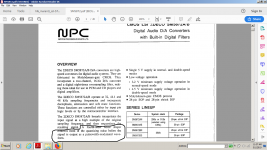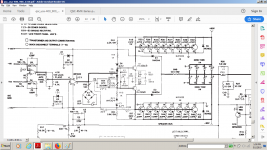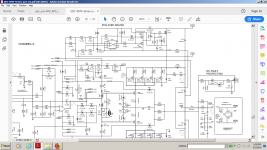The recording engineer/mixer/producer may have used a number of different techniques to help produce a 3D effect. So long as your system is reproducing the recording accurately enough and your brain is adequately flexible and open to suggestion it should work fine.
Thank you, but no measurement being mentioned. I respectfully inquire, perhaps chris719 or others can share his expertise?... So long as your system is reproducing the recording accurately enough and your brain is adequately flexible and open to suggestion it should work fine.
... I don't believe there is anything that is audible but unmeasurable yet to be discovered. ...
I can locate sound source position with one ear in 3D space. Do we have established measurements in relation to 3D quality of sound reproduction?
It's not exactly the future...high quality class d output dac is here for at least 25 solid years now...and Marantz cd 63 was one of the best playerd ever made since its birth.The future is surely that digital will reign. Som much that there will be no need for a diamond input or line stage etc. Look at Lyngdorfs latest products - no line level circuitry - just a PCM -> PWM converter with the gain control implemented by varying the voltage to the output bridge. Whats the stage-count for that? 0. Maybe one (1) - and for the whole system, not just for the "pre-amp". This is the end-station architecture. Less-is-more.
And it will be superior to anything made before. If we want the truth. Can you handle the truth? You want me on that wall.... 🙂
//
Class d improved constantly over the years.Now we have class d amps considered high end... not just fan speed synchronizer that allows our sh..t miss the fan .
Attachments
This technique is used in most op-amp operated equipment with success...47...100 ohms in instrumentation ...With increasing current you need to make the resistor smaller and the capacitor higher and at some point you can't meet the demands, you need some inductance or you need to move the rc network before the reg , but for reasonable loads it works flawlesly even with very high slew rate electronics if the capacitors are good quality.In all my line stages, each opamp has a 22 Ohm resistor in series with each supply pin and a local 100 uF to ground plus the usual 0.1 etc.
At some point i realized that many of the best players of the past didn't even have a regulators for the analog side , they just used good quality capacitors.
Let-me answer:1-First, I don't believe there is anything that is audible but unmeasurable yet to be discovered.
2 Second, I don't think there is some intrinsic quality to ICs that makes them "sound bad" as some here seem to believe.
3-If you want to call me deaf... well, there's a good statistical chance that my hearing is better than yours.
1- Ok, put a mike in front of your speaker at your listening point. Play 5 sec of music and record-it. Compare the wave forms with the original source. Just think about this.
2- Don't you understand the difference between "Sound bad" and "sound different" ? This said, I use ICs that I prefer to a lot of discrete circuits. My system, apart some power amps, is entirely IC based.
3- To be able to discriminate something with our hearing is not a question of response curve. It is a question of culture. (Your wife's face in a crowd).
By example, lot of people listen to music vertically. Musicians listen horizontally : the play of each instrument. Most of people do not know the sound of the instruments. How many are able to make the difference between a Steinway and a Bechstein ? A Gibson 335 and a Fender telecaster ?
How many people have any knowledge about how is supposed to sound a track, so how can they judge of their defects ?
How many system are able to reproduce all the details in a recording, micro dynamic, separation etc ?
A little game, to illustrate how we can listen differently, depending on our culture:
hcj.mp3
Not a little detail, but something enormous that will enjoy all the musicians or people with a musical culture here.
I will give the solution later.
Last edited:
Musician also like Polytone guitar head amps with njm4558 .Opa2134 sounds either imprecise, either too clean for them in that circuit, depending on what technical explanation they got from their personal audio guru...
I believe that one of the reasons why some people prefer unregulated power supplies in their amps is the fact that, in presence of a violent dynamic attack, the capacitances will discharge and the output voltage of the power supply will decrease. It will help to increase the dynamic of this attack, that is often flatten in the the all process that brings the original sound to your ears (Mics and speakers included).At some point i realized that many of the best players of the past didn't even have a regulators for the analog side , they just used good quality capacitors.
One of the designers that frequent this forum had the opportunity to compare several power supplies (SMPS and Linear) in his last amplifier during listening sessions involving several participants. They were all surprised by the noticeable sound differences between them. No, definitively, our listening impressions cannot be resumed by numbers on a paper.
...
1- Ok, put a mike in front of your speaker at your listening point. Play 5 sec of music and record-it. Compare the wave forms with the original source. Just think about this.
2- Don't you understand the difference between "Sound bad" and "sound different" ? This said, I use ICs that I prefer to a lot of discrete circuits. My system, apart some power amps, is entirely IC based.
3- To be able to discriminate something with our hearing is not a question of response curve. It is a question of culture. (Your wife's face in a crowd).
...
Typical case of the parable of the... err... "Challenged engineers and sound reproduction" 🙂
You should definitely tell this to Patrick Quilter.He missed that class entirely.I believe that one of the reasons why some people prefer unregulated power supplies in their amps is the fact that, in presence of a violent dynamic attack, the capacitances will discharge and the output voltage of the power supply will decrease. It will help to increase the dynamic of this attack, that is often flatten in the the all process that brings the original sound to your ears (Mics and speakers included).
Attachments
Last edited:
I believe that one of the reasons why some people prefer unregulated power supplies in their amps is the fact that, in presence of a violent dynamic attack, the capacitances will discharge and the output voltage of the power supply will decrease. It will help to increase the dynamic of this attack, that is often flatten in the the all process that brings the original sound to your ears (Mics and speakers included).
One of the designers that frequent this forum had the opportunity to compare several power supplies (SMPS and Linear) in his last amplifier during listening sessions involving several participants. They were all surprised by the noticeable sound differences between them. No, definitively, our listening impressions cannot be resumed by numbers on a paper.
Well said, Prof. T.
Long ago, I looked into power supplies and thought a regulator, being part of the signal porcessing chain, should deserve as much TLC as the main gain cell(s), in the time domain as well as the frequency domain.
Alternatively, a good passive PS could work too, like (I hope) the LCLC I'm working on.
So a simple capacitor is slower than an lclc filter...Well said, Prof. T.
Alternatively, a good passive PS could work too, like (I hope) the LCLC I'm working on.
Sorry, but I'm shocked by this unfounded, petty accusation. Do-you think ALL the musicians are zombies ?... depending on what technical explanation they got from their personal audio guru...
Most of the guitarists I know have several guitars and several amplifiers, depending of what they want to do, and do not care about brands and what is inside their gears. They only trust their ears and care for the result. Different tastes, different ingredients. Of course, when they appreciate some particular sound of a colleague, they will look at its gears to figure out how he did. Guru ?
When a chef dines at the table of another chef and enjoys a dish, he will try to guess or know the recipe ... he will interpret in his own way.
Long time ago, I had restored an old AC30 for a good friend, guitarist. Trying to clean the sound for studio work (noise, hum etc.) while keeping or even increasing its own characters, if possible.
A long and passionate work with him, trying various components, tubes, sockets for the tubes in different materials (yes, tubes are microphonic) , electrolytic capacitances, quality of resistances (metal, carbon etc.) etc. Do you think any of us were under any kind of guru influence ?
Last edited:
Maybe he was being cheap and wanted a way to eliminate output transistor mica washers 😉.You should definitely tell this to Patrick Quilter. He missed that class entirely.
Dan.
I built clones of Vox ac30 ,peavey c-30 and mesa dual rectifier (2 and 3 channels ) a decade ago and i had this talk about a well known Polytone cab three weeks ago with a very good guitar player who's also passionate about electronics.He is technically minded(which is rare) and i could have a good talk with him about this and not only this aspect.
You cannot improve vox ac 30, nor you can improve any guitar equipment as it was made with a clear purpose the way it was done.Artists are looking more into the novelty of a sound than into the technical aspects.
You cannot improve vox ac 30, nor you can improve any guitar equipment as it was made with a clear purpose the way it was done.Artists are looking more into the novelty of a sound than into the technical aspects.
So a simple capacitor is slower than an lclc filter...
Top speed doesn't win a race.
?You cannot improve vox ac 30
Ask my Friend.
What we did ? Shielded all the electronic enclosure. Changed all the noisy parts for better ones, including some resistances and potentiometers. Added more microphonic effect for the "overdrive"(Sustain), less in some other place for a cleaner sound (damped tube sockets).
Believe-me or not, we did not killed its "Beatles" character. On the contrary. He told-me recently that this amp is still one of its preferred, with one of its "Mesa Boogie".
This friend (we met-us in 1968), which is one of the best guitarist I've ever met, know what he is doing, his cellar is a 'violin workshop'.
Long time ago, he did an incredible quest of Graal, crossing the US from east to west, with stops in each guitar shop on the way... to came back in Europa with a telecaster ... witch is, with his impressive old Gibson 335 ... a miracle.
Spatial information integrity, distortion, compression, whatever is available related to reproduction of source localization information in 3D space.A measurement of what exactly? 3Dness?
- Status
- Not open for further replies.
- Home
- Member Areas
- The Lounge
- John Curl's Blowtorch preamplifier part III


